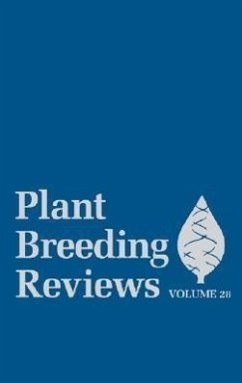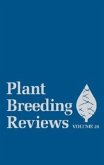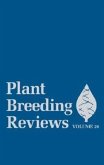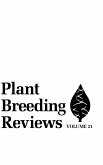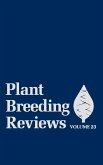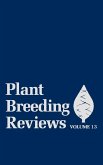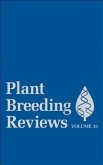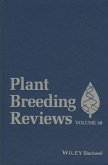Plant Breeding Reviews, Volume 28
Herausgeber: Janick, Jules
Plant Breeding Reviews, Volume 28
Herausgeber: Janick, Jules
- Gebundenes Buch
- Merkliste
- Auf die Merkliste
- Bewerten Bewerten
- Teilen
- Produkt teilen
- Produkterinnerung
- Produkterinnerung
Plant Breeding Reviews presents state-of-the-art reviews on plant genetics and the breeding of all types of crops by both traditional means and molecular methods. Many of the crops widely grown today stem from a very narrow genetic base; understanding and preserving crop genetic resources is vital to the security of food systems worldwide. The emphasis of the series is on methodology, a fundamental understanding of crop genetics, and applications to major crops. It is a serial title that appears in the form of one or two volumes per year.
Andere Kunden interessierten sich auch für
![Plant Breeding Reviews, Volume 29 Plant Breeding Reviews, Volume 29]() Plant Breeding Reviews, Volume 29417,99 €
Plant Breeding Reviews, Volume 29417,99 €![Plant Breeding Reviews, Volume 26 Plant Breeding Reviews, Volume 26]() Plant Breeding Reviews, Volume 26417,99 €
Plant Breeding Reviews, Volume 26417,99 €![Plant Breeding Reviews, Volume 21 Plant Breeding Reviews, Volume 21]() Plant Breeding Reviews, Volume 21417,99 €
Plant Breeding Reviews, Volume 21417,99 €![Plant Breeding Reviews, Volume 23 Plant Breeding Reviews, Volume 23]() Plant Breeding Reviews, Volume 23417,99 €
Plant Breeding Reviews, Volume 23417,99 €![Plant Breeding Reviews, Volume 13 Plant Breeding Reviews, Volume 13]() Plant Breeding Reviews, Volume 13417,99 €
Plant Breeding Reviews, Volume 13417,99 €![Plant Breeding Reviews, Volume 35 Plant Breeding Reviews, Volume 35]() Plant Breeding Reviews, Volume 35308,99 €
Plant Breeding Reviews, Volume 35308,99 €![Plant Breeding Reviews, Volume 38 Plant Breeding Reviews, Volume 38]() Plant Breeding Reviews, Volume 38264,99 €
Plant Breeding Reviews, Volume 38264,99 €-
-
-
Plant Breeding Reviews presents state-of-the-art reviews on plant genetics and the breeding of all types of crops by both traditional means and molecular methods. Many of the crops widely grown today stem from a very narrow genetic base; understanding and preserving crop genetic resources is vital to the security of food systems worldwide. The emphasis of the series is on methodology, a fundamental understanding of crop genetics, and applications to major crops. It is a serial title that appears in the form of one or two volumes per year.
Hinweis: Dieser Artikel kann nur an eine deutsche Lieferadresse ausgeliefert werden.
Hinweis: Dieser Artikel kann nur an eine deutsche Lieferadresse ausgeliefert werden.
Produktdetails
- Produktdetails
- Verlag: Wiley
- Volume 28 edition
- Seitenzahl: 352
- Erscheinungstermin: 2. Januar 2007
- Englisch
- Abmessung: 234mm x 161mm x 23mm
- Gewicht: 594g
- ISBN-13: 9780471997986
- ISBN-10: 0471997986
- Artikelnr.: 20967454
- Herstellerkennzeichnung
- Libri GmbH
- Europaallee 1
- 36244 Bad Hersfeld
- gpsr@libri.de
- Verlag: Wiley
- Volume 28 edition
- Seitenzahl: 352
- Erscheinungstermin: 2. Januar 2007
- Englisch
- Abmessung: 234mm x 161mm x 23mm
- Gewicht: 594g
- ISBN-13: 9780471997986
- ISBN-10: 0471997986
- Artikelnr.: 20967454
- Herstellerkennzeichnung
- Libri GmbH
- Europaallee 1
- 36244 Bad Hersfeld
- gpsr@libri.de
Jules Janick obtained his PhD in Plant Genetics and Breeding and is a Professor of Horticulture and Landscape Architecture at Purdue University.
Contributors.
1. Dedication: Norman E. Borlaug The Humanitarian Plant Scientist Who
Changed the World (Rodomiro Ortiz, David Mowbray, Christopher Dowswell, and
Sanjaya Rajaram).
2. The Genetic Basis of the Green Revolution in Wheat Production (Richard
M. Trethowan, Matthew P. Reynolds, J. Iván Ortiz-Monasterio, and Rodomiro
Ortiz).
I. Introduction.
II. Changes in Plant Architecture and Photoperiod Response.
III. Changes in Physiology and Adaptation.
IV. Changes in Disease Resistance.
V. Changes in Genetic Diversity.
VI. Changes in Product Quality.
VII. Conclusion.
Literature Cited.
3. Breeding Maize for Tolerance to Soil Acidity (Shivaji Pandey, Luis
Alberto Narro León, Dennis Keith Friesen, and Stephen Robert Waddington).
I. Introduction.
II. Agronomic and Management Solutions to Soil Acidity.
III. Why Breeding Might Be an Option, and for Whom.
IV. Genetics of Tolerance to Soil Acidity in Maize.
V. Progress from Breeding Maize for Tolerance to Soil Acidity.
VI. The Future of Breeding Maize for Tolerance to Soil Acidity.
VII. Integrated Approach to Reducing Losses to Soil Acidity in Maize.
Literature Cited.
4. Phenotypic Selection and Evaluation of Maize Inbreds for Adaptedness (
A. Forrest Troyer).
I. Introduction.
II. Phenotypic Selection During Inbreeding.
III. Evaluation of Maize Inbreds.
IV. Progress 1955 to 2004.
V. Conclusion.
Literature Cited.
5. Transgenic Ornamental Crops (Adelheid R. Kuehnle and Rasika G.
Mudalige-Jayawickrama).
I. Introduction.
II. Flower Color.
III. Fragrance.
IV. Vaselife.
V. Disease and Pest Resistance.
VI. Turfgrass.
VII. Independence from Growth Regulations.
VIII. Conclusion.
Literature Cited.
6. Meiotic Mutations and Crop Improvement (Federica Consiglio, Domenico
Carputo, Luigi Frusciante, Luigi Maria Monti, and Clara Conicella).
I. Introduction.
II. Cytological Tools.
III. Molecular Tools.
IV. Meiotic Genes and Mutations.
V. Applications in Breeding.
VI. Conclusion.
Literature Cited.
7. Molecular Basis and Horticultural Application of the Gametophytic
Self-incompatibility System in Rosaceous Tree Fruits (Martin Goldway, Gal
Sapir, and Raphael A. Stern).
I. Introduction.
II. SC Mutants of GSI Plants.
III. Molecular Methods for Determining Compatibility and Fertilization
Efficiency.
IV. Compatibility and Fruit Yield.
V. Conclusion.
Literature Cited.
8. Genetics of Seed Coat Color and Pattern in Common Bean (Mark J. Bassett
).
I. Introduction.
II. Expression of Seed Coat Genes.
III. Genetic and Developmental Models for Seed Coat Pattern.
IV. A Critical Overview of the Reviews of Prakken and Leakey.
V. Chromosome Locations of Genes Controlling Color and Pattern.
VI. A Protocol for Determining Seed Coat Genotype.
VII. The Future of Seed Coat Genetics Research in Common Bean.
Literature Cited.
Subject Index.
Cumulative Subject Index.
Cumulative Contributor Index.
1. Dedication: Norman E. Borlaug The Humanitarian Plant Scientist Who
Changed the World (Rodomiro Ortiz, David Mowbray, Christopher Dowswell, and
Sanjaya Rajaram).
2. The Genetic Basis of the Green Revolution in Wheat Production (Richard
M. Trethowan, Matthew P. Reynolds, J. Iván Ortiz-Monasterio, and Rodomiro
Ortiz).
I. Introduction.
II. Changes in Plant Architecture and Photoperiod Response.
III. Changes in Physiology and Adaptation.
IV. Changes in Disease Resistance.
V. Changes in Genetic Diversity.
VI. Changes in Product Quality.
VII. Conclusion.
Literature Cited.
3. Breeding Maize for Tolerance to Soil Acidity (Shivaji Pandey, Luis
Alberto Narro León, Dennis Keith Friesen, and Stephen Robert Waddington).
I. Introduction.
II. Agronomic and Management Solutions to Soil Acidity.
III. Why Breeding Might Be an Option, and for Whom.
IV. Genetics of Tolerance to Soil Acidity in Maize.
V. Progress from Breeding Maize for Tolerance to Soil Acidity.
VI. The Future of Breeding Maize for Tolerance to Soil Acidity.
VII. Integrated Approach to Reducing Losses to Soil Acidity in Maize.
Literature Cited.
4. Phenotypic Selection and Evaluation of Maize Inbreds for Adaptedness (
A. Forrest Troyer).
I. Introduction.
II. Phenotypic Selection During Inbreeding.
III. Evaluation of Maize Inbreds.
IV. Progress 1955 to 2004.
V. Conclusion.
Literature Cited.
5. Transgenic Ornamental Crops (Adelheid R. Kuehnle and Rasika G.
Mudalige-Jayawickrama).
I. Introduction.
II. Flower Color.
III. Fragrance.
IV. Vaselife.
V. Disease and Pest Resistance.
VI. Turfgrass.
VII. Independence from Growth Regulations.
VIII. Conclusion.
Literature Cited.
6. Meiotic Mutations and Crop Improvement (Federica Consiglio, Domenico
Carputo, Luigi Frusciante, Luigi Maria Monti, and Clara Conicella).
I. Introduction.
II. Cytological Tools.
III. Molecular Tools.
IV. Meiotic Genes and Mutations.
V. Applications in Breeding.
VI. Conclusion.
Literature Cited.
7. Molecular Basis and Horticultural Application of the Gametophytic
Self-incompatibility System in Rosaceous Tree Fruits (Martin Goldway, Gal
Sapir, and Raphael A. Stern).
I. Introduction.
II. SC Mutants of GSI Plants.
III. Molecular Methods for Determining Compatibility and Fertilization
Efficiency.
IV. Compatibility and Fruit Yield.
V. Conclusion.
Literature Cited.
8. Genetics of Seed Coat Color and Pattern in Common Bean (Mark J. Bassett
).
I. Introduction.
II. Expression of Seed Coat Genes.
III. Genetic and Developmental Models for Seed Coat Pattern.
IV. A Critical Overview of the Reviews of Prakken and Leakey.
V. Chromosome Locations of Genes Controlling Color and Pattern.
VI. A Protocol for Determining Seed Coat Genotype.
VII. The Future of Seed Coat Genetics Research in Common Bean.
Literature Cited.
Subject Index.
Cumulative Subject Index.
Cumulative Contributor Index.
Contributors.
1. Dedication: Norman E. Borlaug The Humanitarian Plant Scientist Who
Changed the World (Rodomiro Ortiz, David Mowbray, Christopher Dowswell, and
Sanjaya Rajaram).
2. The Genetic Basis of the Green Revolution in Wheat Production (Richard
M. Trethowan, Matthew P. Reynolds, J. Iván Ortiz-Monasterio, and Rodomiro
Ortiz).
I. Introduction.
II. Changes in Plant Architecture and Photoperiod Response.
III. Changes in Physiology and Adaptation.
IV. Changes in Disease Resistance.
V. Changes in Genetic Diversity.
VI. Changes in Product Quality.
VII. Conclusion.
Literature Cited.
3. Breeding Maize for Tolerance to Soil Acidity (Shivaji Pandey, Luis
Alberto Narro León, Dennis Keith Friesen, and Stephen Robert Waddington).
I. Introduction.
II. Agronomic and Management Solutions to Soil Acidity.
III. Why Breeding Might Be an Option, and for Whom.
IV. Genetics of Tolerance to Soil Acidity in Maize.
V. Progress from Breeding Maize for Tolerance to Soil Acidity.
VI. The Future of Breeding Maize for Tolerance to Soil Acidity.
VII. Integrated Approach to Reducing Losses to Soil Acidity in Maize.
Literature Cited.
4. Phenotypic Selection and Evaluation of Maize Inbreds for Adaptedness (
A. Forrest Troyer).
I. Introduction.
II. Phenotypic Selection During Inbreeding.
III. Evaluation of Maize Inbreds.
IV. Progress 1955 to 2004.
V. Conclusion.
Literature Cited.
5. Transgenic Ornamental Crops (Adelheid R. Kuehnle and Rasika G.
Mudalige-Jayawickrama).
I. Introduction.
II. Flower Color.
III. Fragrance.
IV. Vaselife.
V. Disease and Pest Resistance.
VI. Turfgrass.
VII. Independence from Growth Regulations.
VIII. Conclusion.
Literature Cited.
6. Meiotic Mutations and Crop Improvement (Federica Consiglio, Domenico
Carputo, Luigi Frusciante, Luigi Maria Monti, and Clara Conicella).
I. Introduction.
II. Cytological Tools.
III. Molecular Tools.
IV. Meiotic Genes and Mutations.
V. Applications in Breeding.
VI. Conclusion.
Literature Cited.
7. Molecular Basis and Horticultural Application of the Gametophytic
Self-incompatibility System in Rosaceous Tree Fruits (Martin Goldway, Gal
Sapir, and Raphael A. Stern).
I. Introduction.
II. SC Mutants of GSI Plants.
III. Molecular Methods for Determining Compatibility and Fertilization
Efficiency.
IV. Compatibility and Fruit Yield.
V. Conclusion.
Literature Cited.
8. Genetics of Seed Coat Color and Pattern in Common Bean (Mark J. Bassett
).
I. Introduction.
II. Expression of Seed Coat Genes.
III. Genetic and Developmental Models for Seed Coat Pattern.
IV. A Critical Overview of the Reviews of Prakken and Leakey.
V. Chromosome Locations of Genes Controlling Color and Pattern.
VI. A Protocol for Determining Seed Coat Genotype.
VII. The Future of Seed Coat Genetics Research in Common Bean.
Literature Cited.
Subject Index.
Cumulative Subject Index.
Cumulative Contributor Index.
1. Dedication: Norman E. Borlaug The Humanitarian Plant Scientist Who
Changed the World (Rodomiro Ortiz, David Mowbray, Christopher Dowswell, and
Sanjaya Rajaram).
2. The Genetic Basis of the Green Revolution in Wheat Production (Richard
M. Trethowan, Matthew P. Reynolds, J. Iván Ortiz-Monasterio, and Rodomiro
Ortiz).
I. Introduction.
II. Changes in Plant Architecture and Photoperiod Response.
III. Changes in Physiology and Adaptation.
IV. Changes in Disease Resistance.
V. Changes in Genetic Diversity.
VI. Changes in Product Quality.
VII. Conclusion.
Literature Cited.
3. Breeding Maize for Tolerance to Soil Acidity (Shivaji Pandey, Luis
Alberto Narro León, Dennis Keith Friesen, and Stephen Robert Waddington).
I. Introduction.
II. Agronomic and Management Solutions to Soil Acidity.
III. Why Breeding Might Be an Option, and for Whom.
IV. Genetics of Tolerance to Soil Acidity in Maize.
V. Progress from Breeding Maize for Tolerance to Soil Acidity.
VI. The Future of Breeding Maize for Tolerance to Soil Acidity.
VII. Integrated Approach to Reducing Losses to Soil Acidity in Maize.
Literature Cited.
4. Phenotypic Selection and Evaluation of Maize Inbreds for Adaptedness (
A. Forrest Troyer).
I. Introduction.
II. Phenotypic Selection During Inbreeding.
III. Evaluation of Maize Inbreds.
IV. Progress 1955 to 2004.
V. Conclusion.
Literature Cited.
5. Transgenic Ornamental Crops (Adelheid R. Kuehnle and Rasika G.
Mudalige-Jayawickrama).
I. Introduction.
II. Flower Color.
III. Fragrance.
IV. Vaselife.
V. Disease and Pest Resistance.
VI. Turfgrass.
VII. Independence from Growth Regulations.
VIII. Conclusion.
Literature Cited.
6. Meiotic Mutations and Crop Improvement (Federica Consiglio, Domenico
Carputo, Luigi Frusciante, Luigi Maria Monti, and Clara Conicella).
I. Introduction.
II. Cytological Tools.
III. Molecular Tools.
IV. Meiotic Genes and Mutations.
V. Applications in Breeding.
VI. Conclusion.
Literature Cited.
7. Molecular Basis and Horticultural Application of the Gametophytic
Self-incompatibility System in Rosaceous Tree Fruits (Martin Goldway, Gal
Sapir, and Raphael A. Stern).
I. Introduction.
II. SC Mutants of GSI Plants.
III. Molecular Methods for Determining Compatibility and Fertilization
Efficiency.
IV. Compatibility and Fruit Yield.
V. Conclusion.
Literature Cited.
8. Genetics of Seed Coat Color and Pattern in Common Bean (Mark J. Bassett
).
I. Introduction.
II. Expression of Seed Coat Genes.
III. Genetic and Developmental Models for Seed Coat Pattern.
IV. A Critical Overview of the Reviews of Prakken and Leakey.
V. Chromosome Locations of Genes Controlling Color and Pattern.
VI. A Protocol for Determining Seed Coat Genotype.
VII. The Future of Seed Coat Genetics Research in Common Bean.
Literature Cited.
Subject Index.
Cumulative Subject Index.
Cumulative Contributor Index.

